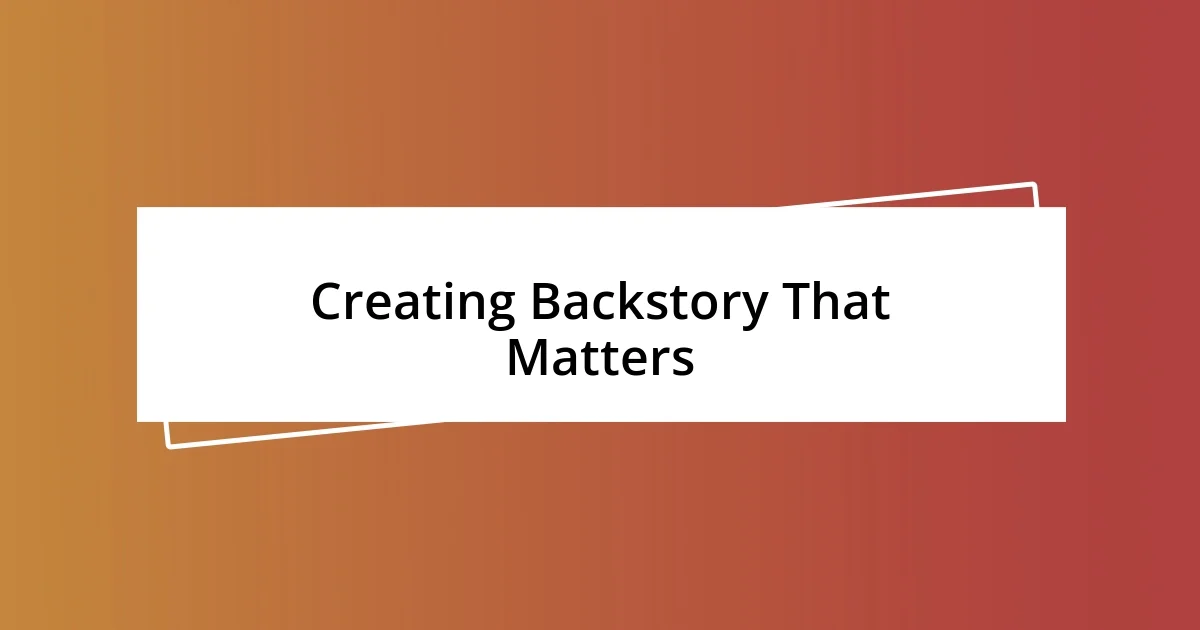Key takeaways:
- Utilizing backstory and character flaws enriches characters, making them more relatable and authentic through their struggles and motivations.
- Dynamic relationships and dialogue are vital for illustrating character growth, revealing inner conflicts, and enhancing emotional depth in narratives.
- Feedback is crucial for character development, helping writers identify areas for improvement and deepen reader connection by revisiting character arcs and motivations.

Understanding Character Development Techniques
Character development techniques are the building blocks of any compelling narrative. I remember a time when I struggled with creating a believable character arc for my protagonist; it felt like trying to construct a house without a foundation. Understanding that characters must grow and evolve in response to their experiences truly transformed my writing process.
One powerful technique I’ve found is the use of backstory. When I crafted a detailed history for one of my characters, it was like peeling back layers of an onion. I discovered motivations and fears that shaped their actions in the present. Have you ever found that a character’s hidden past makes them more relatable or intriguing? It’s fascinating how we can connect with fictional people simply because they mirror real-life complexities.
Another technique that has always resonated with me is the “flaw” approach. Every person has imperfections, and when I give my characters vulnerabilities, it breathes authenticity into their portrayal. I once created a character who was fiercely independent but also afraid of intimacy. As I navigated their journey, I could feel the conflict and tension, making their eventual growth so much more rewarding. Engaging with characters in such a deep way not only enriches the narrative but also allows readers to see pieces of themselves reflected back.

Identifying Character Arcs in Stories
Identifying character arcs in stories is crucial for understanding how characters evolve. In my experience, one way to gauge a character’s journey is by examining their changing relationships with other characters. For instance, I once wrote a story where a protagonist started off mistrusting others, only to learn the value of friendship through experiences that shaped him. Observing these relational dynamics can provide a clear view of a character arc unfolding, showcasing growth or even regression.
Additionally, I’ve found that focusing on pivotal moments in a narrative often highlights significant character transformations. Consider the time I crafted a scene where my character faced a moral dilemma. This internal conflict was a turning point that illustrated how far they had come from where they began. It’s these key moments of decision and change that shape a character’s arc, making the story more compelling and relatable.
To simplify this concept further, I think comparing different types of character arcs can be very helpful. Whether it’s a transformational arc, a flat arc, or a tragic arc, each serves a unique purpose in storytelling. Understanding these distinctions has greatly improved my writing, helping me create more nuanced characters.
| Character Arc Type | Description |
|---|---|
| Transformational Arc | Character undergoes significant change, often for the better. |
| Flat Arc | Character remains unchanged but influences others around them. |
| Tragic Arc | Character experiences a downward spiral, facing consequences of their flaws. |

Creating Backstory That Matters
Creating backstory that matters can truly elevate a character’s journey. I recall working on a complex antagonist whose motivations were deeply rooted in a traumatic childhood. By fleshing out their history, I found a nuanced dimension that influenced their choices. It’s incredible how a well-crafted backstory doesn’t just inform a character’s actions; it helps the reader understand their internal struggles, evoking empathy rather than outright condemnation.
To ensure your character’s backstory resonates, consider these elements:
- Key Life Events: Identify pivotal moments that shaped their worldview, like a significant loss or a triumph.
- Family Dynamics: Explore their relationships with family members and how these bonds influence their behavior.
- Cultural Influences: Reflect on how their upbringing and cultural background impact their beliefs and actions.
- Personal Failures and Regrets: Delve into past mistakes that haunt them, adding layers to their personality.
- Ambitions and Dreams: Understand what drives your character, creating a contrast between their past and present.
These components not only enrich the character but also provide a roadmap for their evolution throughout the story.

Using Dialogue to Reveal Character
Using dialogue to reveal character can be one of the most powerful tools in storytelling. I remember crafting a conversation between two characters where one casually dropped a sarcastic remark about their past. This simple line opened a window into their troubled history, instantly making the reader feel the weight of their emotional baggage. It made me realize that the way characters speak can say so much more than their actual words; the tone and delivery provide layers of meaning.
I’ve also found that contrasting dialogue between characters can enhance their distinct traits. For example, in a story I worked on, one character spoke in a clipped, formal tone while another used more relaxed, slang-filled speech. This not only highlighted their differing backgrounds but also emphasized their conflicting values. It begs the question: how much can we truly understand about someone just by listening to the way they talk?
Furthermore, I’ve observed that using dialogue to explore conflict can create tension and propel character development. I recall a pivotal scene where two friends argued about loyalty. As they exchanged heated words, it not only revealed their inner struggles but also showcased their growth. Moments like these show that dialogue is not just a means of communication; it’s a powerful vehicle for character revelation that can engage readers on a deeper emotional level.

Developing Relatable Character Flaws
When I think about developing relatable character flaws, I often reflect on my experience with creating a protagonist who struggled with perfectionism. Initially, I wanted her to be this strong, flawless character, but I realized that her relentless pursuit of perfection actually alienated her from those around her. By showcasing her fear of failure, I discovered a vulnerability that many readers could connect with—how many of us have felt paralyzed by the desire to get everything just right?
One key realization for me was that flaws should not only serve to hinder a character’s journey but also to add depth and relatability. For instance, I crafted a character who was overly cynical, pushing people away with sarcasm. Yet, as I wrote, I found my readers began to empathize with his perspective; beneath the defensive exterior was a person afraid of getting hurt. It’s fascinating how a well-balanced flaw can resonate deeply, inviting readers to consider their own imperfections.
I also learned that flaws can lead to growth if approached carefully. In a recent story, I introduced a character who was notoriously jealous of her friend’s success. As the plot unfolded, I gave her opportunities to confront her jealousy, allowing both the character and the readers to reflect on what drives envy. This aspect sparked discussions among my readers about the nature of comparison and self-worth, highlighting the reality that flaws can be a mirror for our own struggles. Isn’t it powerful to think how a relatable flaw not only shapes a character but also can illuminate something important within ourselves?

Building Dynamic Relationships Between Characters
Building dynamic relationships between characters is essential for creating compelling narratives. One technique I’ve found invaluable is exploring the underlying motivations of each character—understanding what drives them can create tension and connection. For instance, I once wrote a story where two characters had vastly different goals—one craved acceptance, while the other sought control. This imbalance led to explosive confrontations, but it also offered moments of unexpected tenderness, showcasing how vulnerability can emerge from conflict.
In another project, I experimented with the idea of loyalty. I had a pair of friends navigate the murky waters of trust when one betrayed the other. It was thrilling to delve into how their shared history shaped their reactions; emotions ran high, and the dialogue became charged with unspoken questions: Can they ever go back? Would the bond still hold if tested? Through these tense exchanges, I witnessed both characters revealing layers they never intended to show, enriching their relationship beyond the surface.
I’ve also found that showing small, mundane moments can be just as powerful. Think about a scene where two characters are simply cooking dinner together. I remember creating an instinctive banter between them, where their playful teasing unfolded a deeper affection. As readers, we often find ourselves reflecting on the simple nuances in relationships. How do everyday moments shape the way we connect? These subtle interactions not only reveal character depth but also invite readers to consider their own relationships, making the story feel relatable and authentic.

Applying Feedback to Enhance Characters
Feedback is a powerful tool in character development, something I’ve come to appreciate through my writing journey. I remember sharing a draft with a trusted writing group where they noted they couldn’t connect with my protagonist’s motivations. Their insights helped me recognize that I had skimped on their backstory, which was crucial for understanding their current struggles. Once I fleshed out those details, readers began to empathize with her decisions, and I couldn’t help but feel excited about the transformative power of feedback.
Another instance comes to mind when I faced criticism about a character’s arc feeling rushed. Initially, I wanted my readers to root for their growth, but I realized I hadn’t given them enough time to appreciate the journey. After revising the pacing and including more reflective moments, I found readers commenting on how they felt invested in the character’s progress. It struck me that slowing down often allows deeper connections to form—an important lesson about the role of feedback in honing character depth.
I’ve also found value in receiving feedback from outside my usual circle, like beta readers who bring fresh perspectives. One individual pointed out that my character’s internal conflicts felt one-dimensional. Encouraged by their honesty, I revisited the character’s emotional landscape, unraveling layers that had previously gone unnoticed. It’s fascinating how different viewpoints can breathe life into a character, pushing them away from cliché and toward something richer and more nuanced. Have you ever had feedback shift your perception of a character completely? I believe such moments are gold in the writing process, reminding us of the collaborative nature of storytelling.














